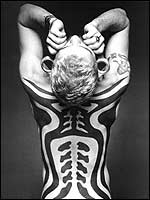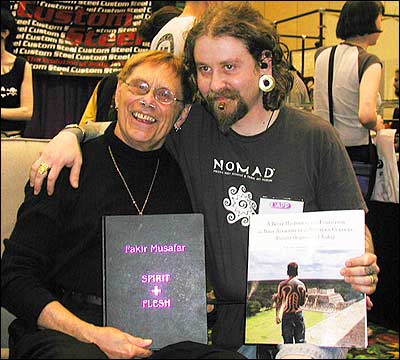
Emulation and Idolization
Counterpoint by Blake of Nomad "A ritual can be described as the enactment of a myth. By participating in a good, sound ritual, you are actually experiencing a mythological life, and it's out of this that one can learn to live spiritually."The myth of the Modern Primitive — a term coined by Fakir Musafar some twenty years ago when the body modification movement was in its infancy — is now applied broadly to anyone whose personal modification can be traced to an existing (or once existing) ancient or primitive culture; a tribal tattoo or a stretched earlobe for example. Emulation or idolization, as Shannon suggests, can imply a mindless "because-it's-cool" mentality — one based merely on aesthetic admiration. While anyone who can see must respect a Polynesian tattooed full body suit or the lobes of an elder Dayak, I suggest that the inclination toward tribal body modification transcends cultural barriers. To refer to primitive cultures in general as "brutal and repressive" (does our own regime not brutally repress other societies around the world?) is to ignore the fact that these cultures, despite their "unsophisticated sociological moral structures" (a Western judgment according to Eurocentric ideals) prevailed for, in many cases, thousands of years. The reign of our Western society, a mere two centuries, is a drop in the bucket of time when compared with, for example, Egyptian dynasties that lasted over 3,000 years, did not destroy their environment, and left a legacy of architecture, high culture, art, jewelry, and demonstrated mastery over geometry. Recent archaeological evidence suggests that the labor force that constructed the great pyramids was well cared for — after all, a hungry worker gets little done. A vast network of modest domiciles, marketplaces, shops, even brothels and wine cellars tell us that although people died, the Pharaoh's workforce was well organized, well rested, and drank, ate, and got laid. The success of any civilization historically has depended on a social hierarchy, political or military infrastructure, and a spiritual, ritualistic, or religious dogma enacted by those "closest to the Gods". Traditionally, tattoos and piercings were incorporates of that spiritual and social fabric. In Egyptian culture (the example I am using here), contrary to what Shannon suggests, it was primarily the upper-class who were tattooed and pierced. The propaganda, mind control, and military threat utilized by the Nazi party affected societal control in a way much different than Aztec priests offering human sacrifice. Although prisoners of war were sacrificed, there was also an entire order of people who were offered consensually. In fact, these people were revered and considered it a high honor to have their blood and themselves offered to the Gods. Today, our own government utilizes many of Hitler's principals of power (military threat, economic sanctions, propaganda, etc.) but "human sacrifice" no longer has the context of ritual and the spirit world. War is brutally and arbitrarily effected with technology and sophisticated weaponry (war is a timeless human motif; ancient or contemporary)... we need not even look our enemy in the eye.
I believe today's "Modern Primitive" rarely supposes these "rituals (profound) and modifications (beautiful)" to be true expressions to aspire to of the romanticized "noble savage". Rather, the primary reasoning for modern people to modify their bodies in a primitive fashion has more to do with aesthetics than rituals; an innate genetic predisposition of all humans. Modern people have the same human inclination as the primitive tribesman.
It is our societal context, lack of ritualistic format, and our disassociation from our own tribal past that is the difference. With self-education and practice we can rediscover these things. It is more than curious to me that cultures separated by time and geography practiced nearly identical forms of body modification. In fact, the stretched earlobe is the single most prevalent and occurring form of body modification in human history (I will spare the reader by not listing those cultures here). This suggests a deeper intuition that transcends race and culture. The act of "taking control", as Shannon suggests, is in fact a human necessity. I don't think it is possible to presuppose or describe simply people's motivation to self-decorate and modify. In a society nearly devoid of ritual, the 18th birthday navel piercing and mini-tribal tattoo is a modern Western-derived rite of passage. It is not one handed down by our elders, but a newly reinvented one (because tribal drives are still buried inside the genetic memory of the suburban American girl), and one with valuable social and even spiritual potential. Spirituality is very much about transcendence (of fear of pain, of social stigmas, and so on) and in any capacity is a deeply personal experience (even if we cannot articulate its meaning)... if it happens at all. It is an ironic juxtaposition indeed that the "underground subculture of the Modern Primitive" is a "system (self)sustaining" within mainstream society. This society whose premise of conformity and normality omit modifying the body altogether as social necessity — one of conformity and "sustaining the group" above all else — is the mainstream of unmodified individuals! The evolution of the individual, I agree, must again take precedence over that of sustaining the society because as a society, we are fractured and subdivided (the tribal connection to our collective human past has the potential to bond all of us together). Individual freethinkers must again step into the limelight of humanity to save us from ourselves. With any mass-produced cultural product (religion, pop music, body jewelry, or a government-engineered ignorant society) the potential for transformative experience is reduced to a simple mathematical equation — percent and ratio. There will always be a few fortunate individuals within the group who will delve deeper and due to early conditioning, personal experiences, acquired knowledge, and individual constitution gain far more than the "mindless masses" from their transformations. The "thick fog of fashion" pervades every aspect of adornment, regardless of time in history or civilization. Our own ignorance (culturally and collectively) is ultimately all that will damage body modifications's ability to enlighten. Again it comes down to the individual. Fuck the group. Know yourself and then relate to those who are like-minded and God forbid a few of you hang out and become a group... at least in "my group" everyone designed their own tattoos.... In a global society another strange juxtaposition of culture has occurred. Many tribal people now emulate and idolize tattoos of the West. On a trip through the rain forests of Central America with my wife two years ago, in the middle of nowhere, at a small stand by the side of the road, we got out to stretch our legs. Several heavily tattooed midgets of mixed Spanish-Mayan descent came out of the woodwork to check me out. They were covered with images of Elvis, skulls and crossbones, daggers, pinup girls and WWII airplanes. And there I was with my "tribal" body suit (all of my designs derived from dreams and vision quests marking significant times of my life). We checked each other out, shook hands and smiled a lot... a certain unspoken understanding had transpired. In an age of cross-cultural-trans-global-sociological influence, who was emulating and idolizing who? It no longer matters.
PS. Shannon's thoughts on corporations and craftsmen I am in agreement with, as well as his advice on the ways one might obtain a meaningful tattoo (avoiding fllash). If you want the same tattoo every Joe has — you know, that one on the wall — why bother? However, if that Tasmanian Devil has deep personal meaning for you, then you did choose the right tattoo.
 The grandson of dental surgeon, noted socialite, and traveller Dr. Naomi Coval, Blake Andrew Perlingieri was inspired by his grandmother's travels to remote tribal areas in the early to middle parts of the 20th century.
The grandson of dental surgeon, noted socialite, and traveller Dr. Naomi Coval, Blake Andrew Perlingieri was inspired by his grandmother's travels to remote tribal areas in the early to middle parts of the 20th century.Professionally, Blake began his carreer in 1990 at San Francisco's premier piercing studio, Body Manipulations. At this time the only other studio was Gauntlet, L.A.. In 1993, Blake and his former partner, Kristian White, opened Nomad, the first tribal studio in the industry. Blake and Nomad have been featured numerous times in Fakir's Body Play and all of the early publications and TV media of the day. In 1995, Nomad opened Australia's first piercing studio in Melbourne. From 1996 to 1998 Blake brought his tribal gospel to the east coast and operated Venus with Maria. In 1998, Blake returned west to open as sole proprietor Nomad Precision Body Adornment and Tribal Art Museum. Combining his famous jewelry collection with his recently inherited grandmother's tribal art, Blake seeks to educate the children of the future, raise awareness about endangered tribes, and provide a cultural and educational context to body adornment for modern people. The photo on the right was taken by Fakir Musafar.
Copyright © 2003 BMEZINE.COM. Requests to republish must be confirmed in writing. For bibliographical purposes this article was first published July 27, 2003 by BMEZINE.COM in Tweed, Ontario, Canada. All guest columns | Return to BME/News |
